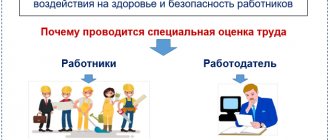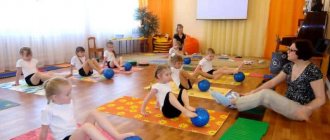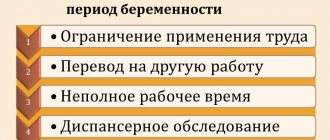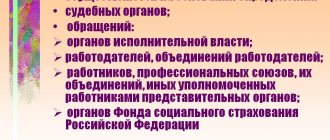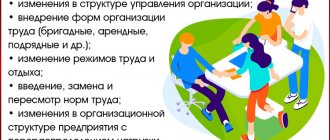The methodology for conducting a special assessment of working conditions is determined by the relevant regulations, which abolished the certification procedure at workplaces that was previously carried out. All the main issues of carrying out a special assessment of working conditions (hereinafter also referred to as SOUT), including the assessment procedure itself, the interpretation of its results and responsibility for violation of established rules, will be discussed in our article.
Legislation on the methodology for special assessment of working conditions
Order No. 33n on SOUT (as amended by Order No. 24n)
SOUT method. Who conducts the assessment, what is checked?
Interpretation of the results of a special assessment of working conditions
Report on the implementation of SOUT and declaration of compliance with working conditions
Responsibility for violations related to SOUT
You can find more complete information on the topic in ConsultantPlus. Full and free access to the system for 2 days.
Methodology SOUT 33n with modifications
The methodology for conducting SOUT 33n with changes for 2020 is an updated document compared to the original edition of 2014. Major additions:
- Paragraph 29 of the Methodology has been completely revised, significantly expanding the principles of attributing the effects of biological factors to determining working conditions.
- New groups III and IV pathogens of biological harmful and dangerous factors have been introduced.
- In the classifier of harmful and dangerous factors, opportunistic microorganisms are separated into a separate group from the general group of pathogenic microorganisms.
- Harmful production factors related to artificial lighting have been identified for subway workers and other personnel working underground.
The changes did not affect the frequency of special assessments of working conditions; it remains 5 years.
SOUT method. Who conducts the assessment, what is checked?
The methodology for conducting a special assessment of working conditions involves the sequential implementation of 4 activities:
- Identification of unfavorable production factors.
- Analysis and measurement of the impact of negative phenomena in the production environment.
- Correlation of working conditions at the tested workplace with classes (subclasses) of workplace hazards, taking into account the level of influence of identified unfavorable production factors on work activity.
- Recording the results of the inspection.
The inspection is carried out by an expert - an employee of a specialized organization authorized in accordance with Law No. 426-FZ (Article 19) to conduct special assessment. The results of the inspection are approved by the commission for the implementation of the special assessment system, organized within the framework of the enterprise being inspected.
Unfavorable production factors are identified by analyzing the information/documents provided by the employer (clause 4 of Appendix No. 1 to Order No. 33n):
- technical documentation for equipment used by workers in production;
- documentation classifying the technological process;
- job descriptions;
- design documents on the arrangement of production facilities;
- characteristics of the raw materials used in the work;
- certificates and documents on compliance with established standards of production equipment, materials, raw materials, technological processes;
- the results of studies and measurements of adverse environmental manifestations previously conducted at the same production site;
- existing proposals from members of the workforce regarding the detection of unfavorable production factors at their places of work.
In addition, to detect unfavorable factors, workplaces and manufactured products are examined, and employees and their managers are interviewed.
Preparation for carrying out SOUT
The organization of a special assessment of working conditions is determined by Article 9 of the Federal Law of December 28, 2013 No. 426-FZ.
Preparation for a special assessment of working conditions can begin either with the formation of a commission, or with the selection of an organization that will directly conduct the special assessment of labor conditions (in principle, this sequence is not important). In any case, responsibility for organizing the implementation of special labor training falls on the employer, who is obliged to:
Step. 1. Conclude an agreement
The employer must enter into a civil law agreement with an organization authorized to conduct special labor training (requirements for such organizations are set out in Article 19 of Federal Law No. 426-FZ).
Step 2. Create a commission
The employer, by his order, is obliged to form and head a commission on SOUT, which should include:
- chairman - a representative of the employer (for an individual entrepreneur - the individual entrepreneur personally);
- occupational safety specialist (if there is not one on staff, you will have to enter into an agreement with a third-party specialist);
- representatives of the trade union (if there is one, if there is no trade union, there is no need to include);
- other specialists of the employer at his discretion.
The number of commission members together with the chairman must be an odd number.
Representatives of the organization that will directly conduct the SOUT are not included in the number of commission members.
The employer determines the timing of the special assessment of working conditions by his order and schedule.
Report on the implementation of SOUT and declaration of compliance with working conditions
The final results of the audit are recorded in a report, which is generated by the expert company in accordance with the requirements of Section 5 of the SOUT implementation methodology. The form of the reporting document is defined in Appendix No. 3 to Order No. 33n, and the procedure for filling it out is in Appendix No. 4 to the same order. The report is signed by all members of the SOUT commission and approved by its chairman.
Within a month from the date of approval of the report, guided by the provisions of the order of the Ministry of Labor “On the form and procedure for filing a declaration...” dated 02/07/2014 No. 80n, the company is obliged to send a declaration of compliance with labor conditions to the regional state labor inspectorate (hereinafter referred to as GIT). In this case, several key requirements must be met:
- The declaration is generated in relation to those workplaces where no adverse production phenomena have been detected.
- The declaration is compiled in the form established by Appendix No. 1 to Order No. 80n.
- The declaration can be submitted electronically by filling out a special form on the Rostrud website and certifying it with an electronic digital signature.
- If the return was returned due to improper execution, the document must be corrected and submitted again.
Procedure for carrying out SOUT
According to the SOUT methodology, all measurements and research are carried out by the organization with which the employer has an agreement. The employer himself is only present during the measurements and can:
- require justification for relevant results;
- appeal the results to the federal labor inspectorate.
In addition, the employer is obliged:
- provide representatives of the organization with the information they need, which may characterize the working conditions at the workplace included in the special assessment schedule;
- do not interfere in any way with representatives of the organization carrying out measurements and research.
Therefore, this section highlights the procedure for the actions of specialists and experts of the invited organization, who, although formally included in the commission, act independently.
First stage. Identification
According to the methodology, when carrying out identification, the following are taken into account:
- characteristics of equipment and raw materials used in the labor process;
- results of previous studies and measurements;
- cases of industrial injuries or occupational diseases;
- suggestions from the workers themselves.
The list of factors to be identified is compiled by the commission on the basis of state labor protection standards.
Identification is carried out by an expert of the invited organization and is carried out by identifying and comparing the names of the identified factors, the factors set out in the classifier to Order 33 n.
If no harmful or dangerous factors are identified, the expert records this fact in the conclusion, and information about working conditions at a given workplace is subject to inclusion in the declaration of compliance of working conditions with state regulatory requirements.
Identification is not carried out for workplaces that:
- included in the lists according to which the early assignment of an old-age pension is carried out;
- upon admission to work, special benefits and compensation are established;
- have already been identified as having harmful or dangerous production factors.
Second phase. Research
If an expert finds similarities in names, he recognizes them as harmful or dangerous and orders a study to determine their actual values.
Such research is carried out by testing laboratories accredited in accordance with the established procedure.
The results of such studies are documented in special protocols, which must contain:
- full name of the organization conducting the SOUT, its registration number, accreditation information;
- protocol numbers (must be on each page along with the page number);
- full name of the employer including its location;
- individual workplace number, name of the position, profession or specialty of the employee employed at this workplace;
- names of the harmful or dangerous factor and other information provided for in paragraph 16 of Methodology 33n.
Third stage. Classification
The classification or assignment of one or another harmful production factor is again made by an expert of the invited organization and is carried out in relation to:
- chemical, biological and vibroacoustic factors;
- aerosols;
- microclimate parameters;
- light environment;
- ionizing and non-ionizing radiation;
- intensity and tension of the labor process;
- complex of influencing factors.
The entire classification is made on the basis of special formulas set out in section IV of the methodology approved by order 33n, and is divided into four classes:
- optimal;
- acceptable;
- harmful (includes four subclasses);
- dangerous.
The results of the assignment are formed in accordance with the Appendices to Section IV on the basis of the corresponding standard values.
The employer, in turn, may require a reduction in the class of working conditions in the workplace, for example, if its employees use effective personal protective equipment that has passed mandatory certification, the working conditions (depending on the specific values) may be recognized as harmful not degree 4, but say 2 degrees.
The methodology for reducing the hazard class was approved by Order of the Ministry of Labor dated October 5, 2014 No. 976n.
Fourth stage. Conclusion
The results of a special assessment of working conditions are presented in the form of a report (Appendix No. 3 to Methodology 33n) in strict accordance with Article 15 of Law 426-FZ.
The report is compiled by the organization that conducted the SOUT.
The report is signed by all members of the commission.
The report is approved by the chairman of the commission.
A member of the commission who does not agree with the results of the special assessment has the right to write a special opinion, which must be attached to the report.
From the date of approval of the report, the employer is obliged:
- within three working days, notify the organization that conducted the special assessment;
- no later than 30 days, familiarize employees with the results of the special assessment against signature;
- no later than 30 days, post, if there is a website on the Internet, information about the results of the special labor safety assessment and a list of measures to improve labor safety conditions.
Interpretation of the results of a special assessment of working conditions
Recognition of identified factors of the production environment as unfavorable is carried out by comparing their names with the names specified in the classifier (Appendix No. 2 to Order No. 33n). If there is no match in the names, then the absence of negative phenomena in the production environment is recorded, and the working conditions at this workplace, in turn, are recognized as acceptable. If there is a coincidence between the identified production phenomena and the factors of the production environment identified in the classifier as unfavorable, they are further studied and the level of influence on workers is measured. Surveys and measurements are carried out in accordance with the provisions of the 3rd section of the SOUT methodology.
Further, Order No. 33n prescribes the comparison of actual working conditions at the inspected workplace with classes (subclasses) of working conditions defined by the said normative act. At this stage of the SOUT, it is necessary to be guided by section 4 of the methodology, as well as appendices to it No. 1, 9–14, 16–21, according to which classes (subclasses) of the work environment are assigned depending on the level of influence of a particular production factor and the degree of excess of standards , defined by law as optimal and acceptable.
Frequency of SOUT
Special assessment of working conditions is:
- periodic;
- unscheduled.
Periodic special assessments are carried out once every five years in relation to already inspected workplaces. The period begins from the date of approval of the report.
Unscheduled is carried out when:
- commissioning of newly created jobs;
- changes in the technological process that may affect the level of exposure to harmful factors;
- receiving a written order from the state labor inspectorate;
- change of used PPE and other reasons, etc.
In this case, the employer has clearly established deadlines for carrying out special assessment work, which are 12 (in the first two cases) and 6 months (for all other cases, set out in Article 17 of Federal Law 426-FZ).
In any case, SOUT needs to be planned, including financially. For these purposes, it is advisable to develop a schedule for carrying out the Special Operations Management System, appoint responsible officials and approve the timing of these activities.
Responsibility for violations related to SOUT
The following may be considered violations of the legislation on special assessment of labor conditions:
- failure to implement SOUT in cases specified by law;
- non-compliance with the procedure for carrying out special assessment and assessment;
- incorrect registration of the results of the audit;
- non-compliance with legal requirements related to compensation for employees for working conditions in an unfavorable production environment, identified as a result of the special assessment;
- failure to submit a declaration to the State Tax Inspectorate.
Responsibility in these cases (both for the organization and for its responsible employees) arises under Part 2 of Art. 5.27.1 of the Code of Administrative Offenses of the Russian Federation and entails penalties: from 5,000 to 10,000 rubles. — for officials, from 60,000 to 80,000 rubles. — for legal ones (the amount depends on the circumstances surrounding violations of the law).
So, the methodology for carrying out SOUT is a list of sequential actions carried out by a specialized organization when checking working conditions at the places of service of enterprise employees. Based on the results of the inspection, each place is assigned a certain hazard class. The employer may be held administratively liable for violations during the implementation of the Special Operations Management System. At the same time, the most important document that defines the mandatory requirements for the procedure for assessing working conditions at enterprises is Order No. 33n on the methodology for conducting SOUT - it is this that should be followed in the course of carrying out the above-mentioned activities.
Penalties in case of incorrect assessment
As mentioned above, the manager and the appraiser company are personally responsible for the quality of the inspection, which is supported by legal norms. In case of violation of the procedure, they face punishment in the form of fines (from 5 thousand rubles for individuals and individual entrepreneurs to 200 thousand rubles for appraisal organizations) or suspension from work for up to three years. In some cases of systematic violations, complete disqualification and revocation of the license of appraisal enterprises is expected.
| Approved: | 01/24/2014 Ministry of Labor and Social Protection of the Russian Federation (33n) |
| Published: | Russian newspaper (dated March 28, 2014, No. 71) |
| Is located in: | |
| Normative references: |
|
Definition of classes of working conditions
Then all workplaces where the tests were carried out must be assigned to a certain class (subclass) of working conditions.
Chapter IV of the Methodology determines the procedure for calculations for chemical, biological, factors, under the influence of fibrogenic aerosols, vibroacoustic factors, microclimate parameters, negative effects of the light environment, ionizing and non-ionizing radiation, etc.
In 2020, paragraph 29 of the Methodology on the impact of biological factors was revised: the criteria for classifying the effects of biological factors as hazardous working conditions were expanded, new groups of “three” and “four” pathogens of biologically harmful factors were introduced, and opportunistic pathogenic microorganisms were separated into a separate group.
When classifying working conditions as a class, the severity of the labor process is assessed: dynamic, static loads, the severity of manually moved loads, body tilts, etc. are taken into account. When assessing the intensity of the work process, the expert pays attention to the density of signals, messages, the number of light signals, the load on the speech apparatus, and the monotony of the workload on the employee.
If there is a complex impact of harmful factors, then, according to paragraphs 92-93 of the Methodology, it is assessed which class the factors belong to, and as a result, the highest harmful class (subclass) is established.
Evaluation procedure
The methodology for conducting SOUT, as amended for 2020, is regulated by several main regulations: Federal Law No. 426-FZ dated December 28, 2013 on special assessment, Order No. 33 dated January 24, 2014 “Methodology for conducting special assessment of working conditions.”
According to the law on SOUT (Federal Law 426, order 33 of January 24, 2014 with comments), the special assessment procedure is initiated by the employer, but the inspection itself is carried out by an organization that has the right to do so. The list of enterprises that have received the appropriate permits is available on the Ministry’s website. There you can get all the coordinates of a potential contractor and choose the best option for a specific situation (in 2020, there are 507 such organizations in the register).
The methodology for conducting a special assessment of working conditions in 2020, approved by Order 33 n, consists of several main stages. Let's take a step-by-step look at what needs to be done to check jobs.
Step 1. Find an appraiser
At this level, the employer determines which organization to invite as an appraiser. When choosing a contractor, it is important to understand that all costs of maintenance and the visit of the appraiser will become additional costs. Choose the organization that is located as close as possible to your workplace. Another factor that you should pay attention to is whether the company has its own testing laboratory. Otherwise, the results of the special assessment will not be accepted by the regulatory authorities.
Step 2. Prepare documents
After an organization providing special assessment services has been selected and a contract has been concluded with it, the employer must:
1. Issue an order to carry out the special operational assessment.
2. Determine who will be part of the workplace assessment commission.
3. Decide at which workplaces production factors will be assessed (compile a list of workplaces to be assessed, as required by Methodology 33 on special assessment of working conditions with changes).
4. Create a schedule for conducting a special assessment.
Legislation allows assessments to be carried out not at all workplaces at once, but one at a time. The main thing for officials is that by the end of 2020 everyone has passed the SAT.
Step 3. Assess the changes that have occurred since 2014
Since 2014, significant changes may have occurred in the company's work. Identify new jobs opened in 2020. As for those workplaces where a special assessment was already carried out 5 years ago, confirm that they are not harmful (clause 1, article 17 and clause 4, article 8 of Law 426-FZ, Order 33n on special assessment of working conditions, as amended).
Step 4. Analyze harmful and dangerous production factors
At this stage, the employer and team representatives cannot do anything. They are only present during measurements, and then approve the results of research and evaluation. Experts from the invited organization are required to check:
- physical, chemical and biological factors;
- non-ionizing and ionizing radiation;
- microclimate and light environment parameters;
- complexity of the labor process.
If tests or measurements threaten the life or health of invited evaluators, then a protocol on the impossibility of testing is drawn up. Based on this document, workplaces are recognized as hazardous, and the employer is obliged to notify the State Labor Inspectorate about them within 10 days.
Step 5. Formalize the results of the special assessment
For each workplace, a Workplace SOUTH Map is drawn up, which is included in the report. The form of the report on the special assessment and instructions for filling it out were approved by 33 n (methodology for conducting special assessments) with amendments (the latter were made by order dated November 14, 2016 N 642n). The appraiser is responsible for preparing the report.
The results of the SOUT are confirmed by the signatures of all members of the commission, and they are approved by the chairman of the special assessment commission - the head of the organization or individual entrepreneur. If someone does not agree with the information presented in the report, he writes a reasoned opinion and attaches it to the report.
Based on the results of this stage, it is clear what hazard classes are assigned to specific workplaces, what experts recommend to improve the situation, and how effective the personal protective equipment provided is.
The employer submits declarations of compliance of working conditions with state requirements if there are no harmful and/or dangerous production factors at the workplace. If there are any, then the organization that conducted the assessment sends the relevant information to the Federal State Information System for recording the results of the special assessment within 10 days.
The declaration is submitted by the employer for jobs of class 1 or 2. In 2014–2015, the SOUT methodology stated that it should have been submitted only for jobs with class 2, but in 2020 changes were made, now it is necessary to submit for classes 1 and 2. For for those who submitted earlier, it is automatically extended (Clause 7, Article 11 of Law 426-FZ; Letter of the Ministry of Labor of Russia dated August 30, 2019 N 15-1/OOG-1968), but those who did not submit will have to take care of this . Amendments introduced by Law No. 136-FZ dated 05/01/2016 provided for the application of its provisions from 01/01/2014.
Step 6. Introduce the results of the special assessment to employees and regulatory authorities
After the SAW experts have completed their work, the employer is obliged to familiarize his subordinates with the results of the assessment. Order 33 n gives employees 30 calendar days to inform employees from the date of registration of the results of the SOUT. The same period is provided for publishing the assessment results on the company’s website, if available.
Step 7. Store the results
One of the employer’s responsibilities is to always keep the results of the SOUT at hand. They are necessary in many cases, ranging from inspector visits to proceedings related to insurance rates. By law, the results of a special assessment are valid for 5 years. But there is a list of situations when they lose their relevance. It is necessary to re-evaluate if:
- new workplaces were put into operation;
- the inspection was requested by the inspector or employee representatives;
- the technological process or equipment has changed;
- the composition of the materials and/or raw materials used has been updated;
- personal and collective protective equipment for workers has changed;
- an accident or occupational disease was recorded at the workplace due to exposure to harmful (hazardous) production factors.
Identification of potentially dangerous and harmful production factors
The identification procedure is established by the method under consideration. To some extent it is similar to workplace certification. The presence of different methods for conducting SOUT and automated workplace allows you to fully investigate the enterprise for harmful and dangerous factors that negatively affect the health of employees.
The identification process is carried out in four stages:
- stage one - identification and description of production and labor factors identified at the place of work, as well as sources of dangerous and harmful influences;
- stage two - comparison and identification of coincidences of factors in the workplace with the same indicators from the classifier;
- stage three - deciding on deeper research and measurement of established data;
- drawing up a conclusion based on the identification results.
The entire inspection is carried out by a representative of the expert organization, and its results are approved by the commission.
Changes in the Classifier (Appendix No. 2 – Order of the Ministry of Labor No. 33n dated January 24, 2014)
Changes to the Classifier of Harmful and (or) Dangerous Factors bring it to a more structured form:
- The motley terms “technological equipment”, “technological (production) equipment” and similar ones have been replaced by one - “production equipment”.
- Microclimate parameters in open areas are now included in the modified Classifier (if there is production equipment, raw materials, materials at the workplace that are artificial sources of heat and (or) cold and affect the temperature regime in the production area).
- A biological factor is identified as harmful and dangerous only in workplaces: organizations operating in the field of using pathogens of infectious diseases in humans and animals and (or) in closed systems of genetically modified organisms of III and IV degrees of potential danger in the presence of appropriate permits ( licenses) for the right to carry out such activities;
- organizations operating in the field of using genetically engineered modified organisms of II degree of potential danger in closed systems;
- medical and other workers directly involved in medical activities;
- workers directly involved in veterinary activities, state veterinary supervision and (or) conducting veterinary and sanitary examination.
How to determine the class and subclass of working conditions for medical workers’ jobs?
The Ministry of Health and the Ministry of Labor indicate that for this it is enough to determine the pathogenicity group of microorganisms (pathogens of infectious diseases). Here you need to use Appendix No. 9 to the Methodology for conducting SOUT.
Experts and those who conduct a special assessment of working conditions, in order to determine the pathogenicity group of microorganisms, need to be compared and matched by the name of the disease.
How are pathogenicity groups of microorganisms determined?
The pathogenicity group of microorganisms is determined in accordance with
- “Classification of biological agents that cause human diseases by pathogenicity groups” (Appendix No. 3 to the Sanitary and Epidemiological Rules SP 1.3.3118-13 “Safety of working with microorganisms of I - II groups of pathogenicity (hazard), approved by the resolution of the Chief State Sanitary Doctor of the Russian Federation dated November 28, 2013 N 64),
- “Classification of microorganisms - causative agents of human infectious diseases, protozoa, helminths and poisons of biological origin according to pathogenicity groups” (Appendix No. 1 to the Sanitary and Epidemiological Rules SP 1.3.2322-08 “Safety of working with microorganisms III - IV groups of pathogenicity (hazard) and pathogens parasitic infections, approved by Decree of the Chief State Sanitary Doctor of the Russian Federation dated January 28, 2008 No. 4).
For the purpose of special assessment of working conditions, other sanitary and epidemiological provisions other than the rules SP 1.3.3118-13 and SP 1.3.2322-08 are not applied.
When specially assessing working conditions in medical organizations, all pathogenic microorganisms (causative agents of infectious diseases) that affect the employee during medical activities are taken into account, based on the presence of potential contact with infected patients, or with infected biological material, including blood, secretions (external and internal ) of the human body, taking into account the mechanisms and routes of transmission of pathogenic biological agents (pathogenic microorganisms).
Assessment of working conditions based on the study of documents and reports
The Ministry of Health and the Ministry of Labor indicate that by studying the mandatory statistical surveillance reports, it is possible to determine the names of diseases and the pathogenicity groups of the causative agents of these infectious diseases. The only rule: these documents must be no older than five years ago.
As initial materials when conducting a special assessment of working conditions at the workplace of medical and other workers directly involved in medical activities, along with the documents listed in paragraph 4 of the Methodology, statistical reporting data provided by the organization in the prescribed manner to higher authorities about existing or existing infectious diseases in patients, which determine the presence of exposure to a biological factor in working conditions in the workplace.
To confirm the presence at the workplace of medical and other workers directly engaged in medical activities, contact with pathogenic microorganisms - causative agents of infectious diseases (working under the influence of a biological factor) and further classifying the working conditions in the workplace as a class (subclass) of working conditions according to the biological factor Data from the documentation available in the medical organization is used, which reflects the main and concomitant diseases of the patients (patients), as well as data from federal statistical observation forms.
For example, by orders of Rosstat:
- dated January 28, 2009 N 12, Form N 8 “Information on diseases of active tuberculosis” was approved;
- dated December 31, 2010 N 483, Form N 33 “Information about tuberculosis patients” was approved;
- dated 12/30/2015 N 672 approved form N 61 “Information on the disease caused by the human immunodeficiency virus”;
- dated July 21, 2016 N 355, Form N 12 “Information on the number of diseases registered in patients living in the service area of the medical organization” was approved;
- dated December 22, 2016 N 866 approved form N 14 “Information on the activities of units of a medical organization providing medical care in inpatient settings,” etc.
Information obtained during the study of the specified medical documentation and (or) from federal statistical surveillance forms mandatory for submission by a medical organization is a sufficient basis for establishing the names of diseases and pathogenicity groups of the causative agents of these infectious diseases.
Information in the above and other forms of statistical reporting, required to be provided by a medical organization, is fundamental for classifying the working conditions of medical and other workers into the class (subclass) of working conditions when exposed to a biological factor
Examples of using the technique
In the course of providing medical care to a patient with ARVI, herpes type I and syphilis at the workplace of a worker directly engaged in medical activities, pathogenicity group III is established, in accordance with the Classification of biological agents that cause human diseases, by pathogenicity groups, which corresponds to the presence of the pathogen in this group syphilis - Treponema pallidum. When further classifying the working conditions of an employee's workplace as a class (subclass) of working conditions under the influence of a biological factor using Appendix No. 9 to the Methodology, this corresponds to the harmful class of working conditions of the second degree (subclass 3.2).
When providing medical care to a patient with rhinitis, gastroenteritis, tuberculosis and HIV-infected, the assignment of working conditions in the workplace to the class (subclass) of working conditions under the influence of a biological factor is established according to the highest group II of the pathogenicity of microorganisms, which includes pathogens of the human immunodeficiency virus (HIV) , which, when using Appendix No. 9 to the Methodology, corresponds to the harmful class of working conditions of the third degree (subclass 3.3).
Research and measurements
Often, the organization conducting the special environmental assessment includes a laboratory, which carries out research and measurements of harmful and (or) dangerous factors. Organizations determine their own research methods, but they must be approved and certified. This is necessary to maintain uniformity of measurements. All examinations and measurements are conducted during the employee's normal activities, taking into account the employee's use of his equipment. Measurements must be carried out for all workplaces where harmful and/or dangerous factors have been identified. But if these places are completely similar, then measurements are needed only for 20% of such workplaces (minimum 2 workplaces), and the results will be valid for the entire group.
After testing for each of the identified factors, a protocol is drawn up. The information to be entered into the protocol is indicated in paragraph III. 16 Methods.

